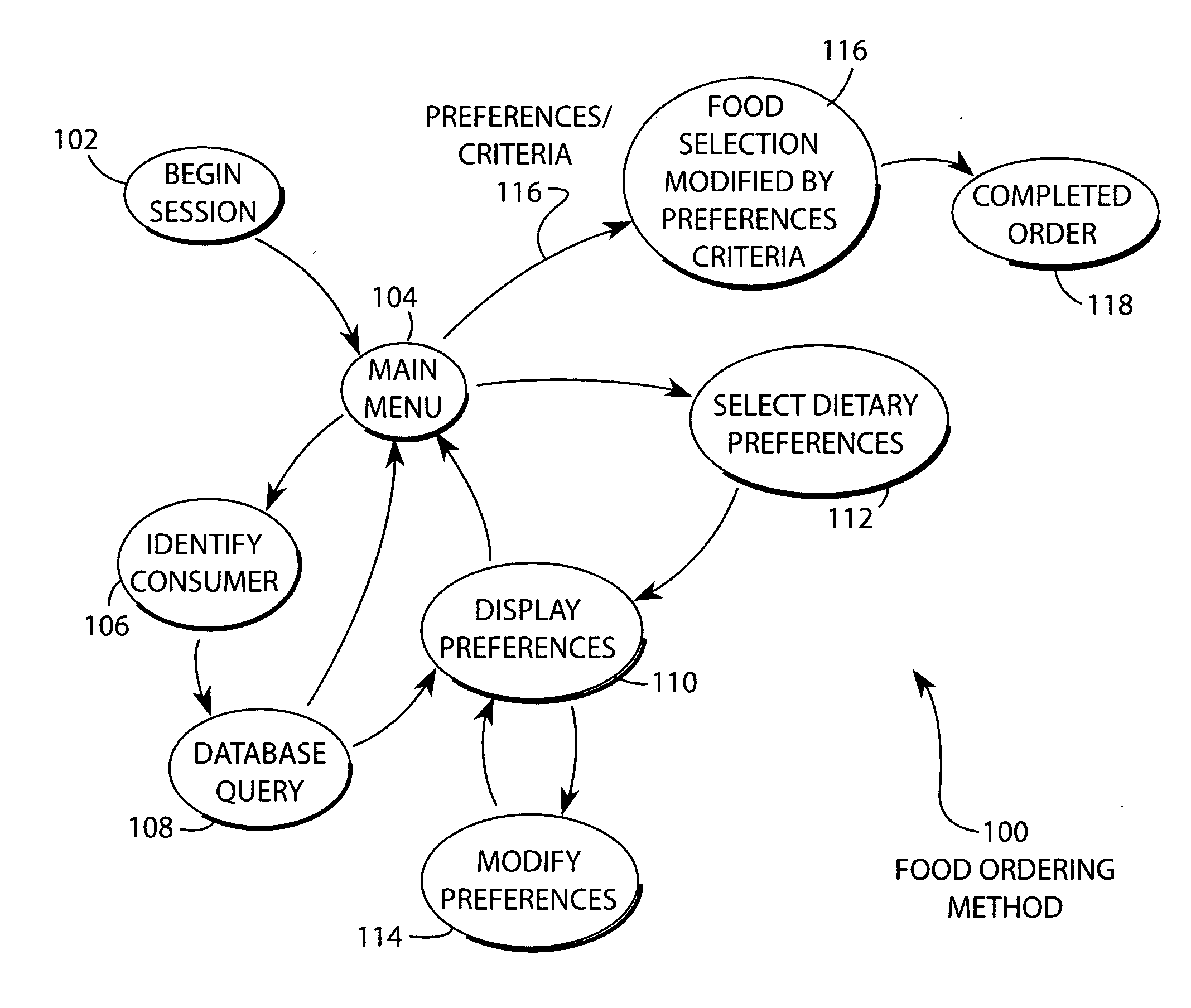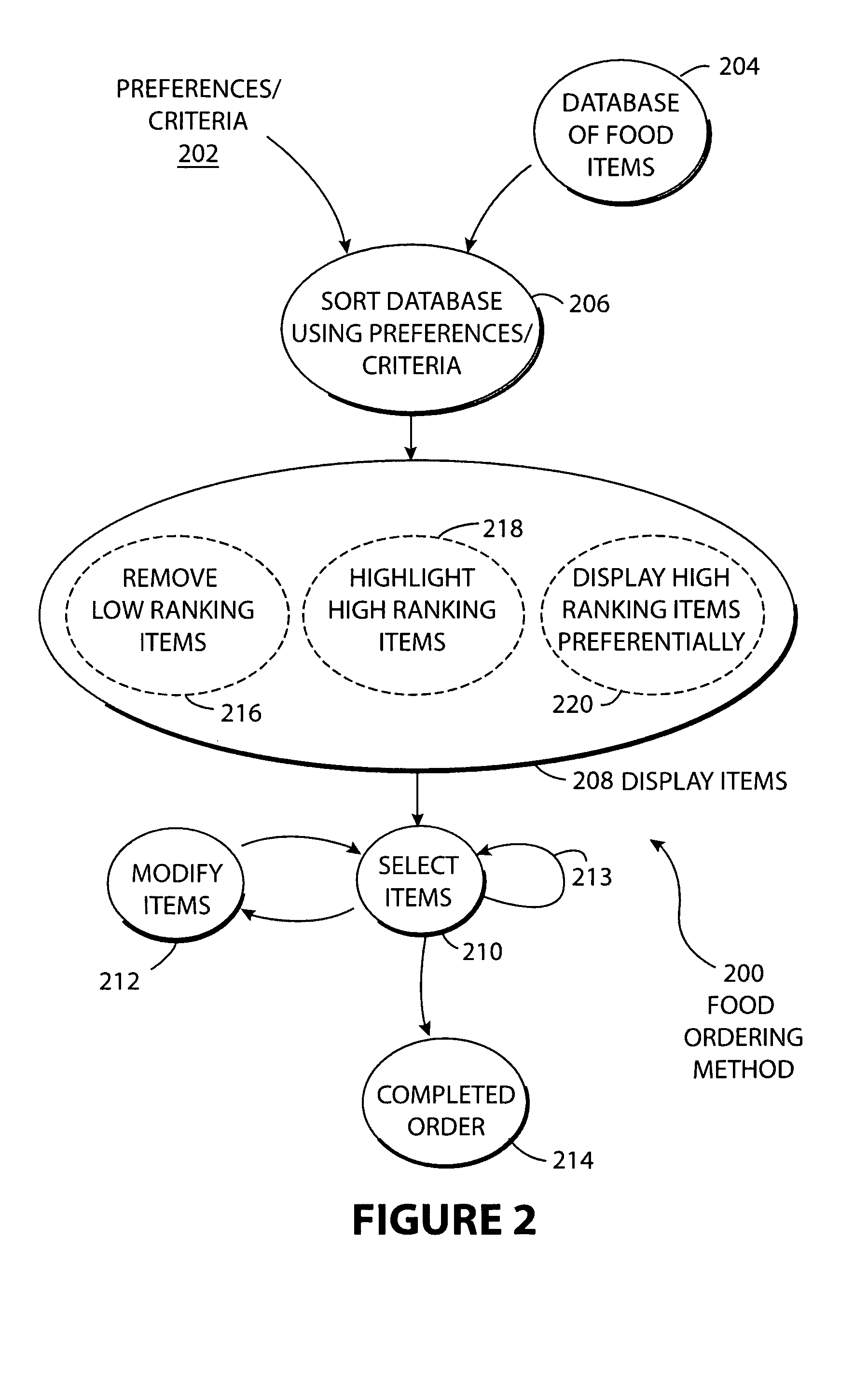Nutritional assistant for kiosk
a kiosk and nutrition assistant technology, applied in the field of point of sale kiosks, can solve problems such as difficulty, consumers may have difficulty in finding appropriate menu choices,
- Summary
- Abstract
- Description
- Claims
- Application Information
AI Technical Summary
Benefits of technology
Problems solved by technology
Method used
Image
Examples
embodiment 100
[0022]FIG. 1 illustrates an embodiment 100 of the present invention showing a method for ordering food on an interactive computer system that uses customer dietary preferences to aid in selection. The session begins in a start screen 102. Activation of the start screen cause the process to proceed to a main menu 104. The customer may be identified in block 106, a database may be queried in block 108, and their particular nutritional preferences or requirements may be displayed in block 110. In some cases, the customer may select dietary preferences in block 112 directly. When the preferences are displayed in block 110, the preferences may be modified in block 114. The criteria and preferences 116 are passed to the portion of the system where food selection is performed by the consumer in block 116. Subsequently, the process proceeds to completed order screen 118.
[0023] The embodiment 100 illustrates a method in which a customer's dietary preferences may be determined so that those p...
embodiment 200
[0030]FIG. 2 illustrates an embodiment 200 of a method for ordering food wherein dietary preferences are used to assist the consumer in selecting items that match the preferences. The preferences or criteria 202 and the database of food items 204 are combined to produce a sorted list of food items in block 206. The items are displayed in block 208, the items selected in block 210, modified in block 212, and repeated as indicated by arrow 213 as necessary to produce a completed order in block 214.
[0031] The preferences and criteria 202 are combined with the database of available food items 204 to classify the food items prior to display. The classification process may involve removing unacceptable items, ranking items based at least in part on how well the items met the criteria, or some other classification process.
[0032] In some cases, the dietary preferences 202 may be combined with other unrelated dietary criteria to yield a sorted list. Such criteria may include factors as prof...
embodiment 300
[0034]FIG. 3 illustrates an embodiment 300 of the present invention showing a method for assisting a consumer in selecting food items that meet consumer dietary preferences. The preferences 302 and database of food items 304 are used in the selection and display of items in block 306. The items may be modified in block 308 and more items ordered as indicated by the arrow 310 to produce a completed order 312.
[0035] The embodiment 300 provides an indicator of certain parameters of interest during the ordering process in block 306. Such indicators may be graphical enhancements to the screen or tabulated numerical values that count calories, fat, sodium, or other calculable values for the particular order.
[0036] When the consumer defines certain parameters of interest, those parameters may be added to the description of the food items and may be tabulated and summed for all of the items in a particular meal order. For example, if the consumer indicates that carbohydrates are of interes...
PUM
 Login to View More
Login to View More Abstract
Description
Claims
Application Information
 Login to View More
Login to View More - R&D
- Intellectual Property
- Life Sciences
- Materials
- Tech Scout
- Unparalleled Data Quality
- Higher Quality Content
- 60% Fewer Hallucinations
Browse by: Latest US Patents, China's latest patents, Technical Efficacy Thesaurus, Application Domain, Technology Topic, Popular Technical Reports.
© 2025 PatSnap. All rights reserved.Legal|Privacy policy|Modern Slavery Act Transparency Statement|Sitemap|About US| Contact US: help@patsnap.com



